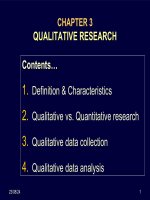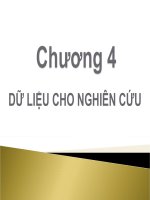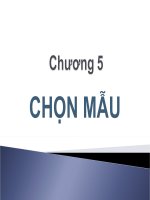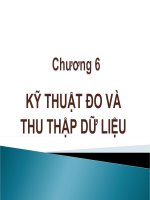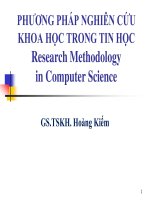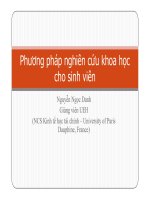Bài giảng chương 2 - RESEARCH DESIGN - phương pháp nghiên cứu khoa học
Bạn đang xem bản rút gọn của tài liệu. Xem và tải ngay bản đầy đủ của tài liệu tại đây (137.75 KB, 28 trang )
Session 2-3
Session 2-3
RESEARCH FORMULATION & DESIGN
Contents
1.
1.
Research classification
Research classification
2.
2.
Formulation of the research project
Formulation of the research project
3.
3.
Research design
Research design
28/05/14
28/05/14
2
2
I.
I. RESEARCH
CLASSIFICATION:
CLASSIFICATION:
I.1. Based on the generalizability of the findings:
Basic research
Applied research
Note: applied research vs. applying research (results)
I.2. Based on the conclusiveness:
Exploratory research
Conclusive/Confirmatory research
28/05/14
28/05/14
3
3
I.3. Based on the form of observed data:
Qualitative research
Quantitative research
I.4. Based on the nature of findings:
Descriptive research
Causal / Associative research
28/05/14
28/05/14
4
4
DISCUSSION QUESTIONS:
–
How to apply business knowledge provided by
descriptive and causal research?
–
How this issue is reflected in your final thesis?
28/05/14
28/05/14
5
5
MANAGERIAL/THEORETICAL PROBLEM
RESEARCH QUESTIONS
RESEARCH OBJECTIVES
RESEARCH SCOPE
LITERATURE REVIEW
MODEL - HYPOTHESES
E
x
p
l
o
r
a
t
o
r
y
/
q
u
a
l
i
t
a
t
i
v
e
r
e
s
e
a
r
c
h
RESEARCH DESIGN
DATA NEEDS & SOURCES
MEASUREMENT SCALES
COLLECTION METHOD
SAMPLING
DESIGN
PLAN FOR DATA ANALYSIS
TEST - ADJUSTMENT
FIELD WORK -
DATA COLLECTION
DATA ANALYSIS & INTERPRETATION
REPORT OF FINGDINGS
RESEARCH PROCESS
E
x
p
l
o
r
a
t
o
r
y
/
q
u
a
l
i
t
a
t
i
v
e
r
e
s
e
a
r
c
h
THE
RESEARCH
PROCESS
28/05/14
28/05/14
6
6
II. RESEARCH FORMULATION
II.1.
II.1.
Introduction
Introduction
–
A difficult and time-consuming stage
A difficult and time-consuming stage
–
Often starting from a broad area/subject of interest
Often starting from a broad area/subject of interest
–
Narrow down to more specific issues
Narrow down to more specific issues
–
Ask what / how / why / … questions
Ask what / how / why / … questions
28/05/14
28/05/14
7
7
II.2. Sources of research topics:
II.2. Sources of research topics:
–
From management problem to be solved
–
From the suggestion of managers / policy makers
–
Limitations / suggestions from previous researches
–
Shortages / Incompleteness of existing theories
–
Experience or observation of the researcher
28/05/14
28/05/14
8
8
II.3. Criteria of a good research topic:
1. Significance by theoretical implications or practical
implications (expected contributions / values)
2. Researchability: the research objects can be
observed, describe, explained or predicted
1. Adequacy:
Complication level / researcher’s skill / experience
Available resources and conditions
28/05/14
28/05/14
9
9
II.4. Writing the research formulation:
1. General background (key research objects / concepts)
2. Defining the management problem / dilemma
3. Statement of the research problem / research gaps
4. Shortages of knowledge / information of the topic
5. Importance / significance of the research
6. Statement of research objectives / questions
7. Scope / presumption of the research
+ The order and emphasis may vary by different situations
+ The logical flow from mgt. problem to research objectives
28/05/14
28/05/14
10
10
Notes to the setting up of research scope
Space & time dimensions
Space & time dimensions
Objects / factors that are beyond the scope of study
Objects / factors that are beyond the scope of study
Clarification of terminologies if needed
Clarification of terminologies if needed
Presumptions for simplifying the research
Presumptions for simplifying the research
Scope of interpretation & generalization of the findings
Scope of interpretation & generalization of the findings
28/05/14
28/05/14
11
11
Example
– Management Style
– Management Style
Nowadays, Western-originated management theories are taught and
disseminated widely in Asian countries. However, some management
educators and practitioners have raised concerns about the validity and
applicability of these theories in culturally different settings, especially the ones
dealing with human behavior (Ardichvili&Kuchinke, 2002; Tsui, 2004).
Two schools of thought address these concerns. Scholars who support the
“divergence process” contend that management theories belong to the science
of human being, that they must be socially or culturally dependent. Therefore,
Western management theories must be reconsidered before applying them in
different cultural settings such as in Asian countries (Tayeb, 1994; Grant,
2004). In contrast, authors supporting the “convergence process” argue that
internationalization and industrialization are the best rationale for the universal
application of commonly adopted approaches to management, regardless of
their origin (Mullins, 1993; Ohmae, 1990). Inspired by this debate, the present
study deals with the following research questions: 1) Are there differences in
the decision making or management styles of managers from different national
cultures? 2) Is management style affected by internationalization, cultural
adjustment or management education?
28/05/14
28/05/14
12
12
Case
1 – Market Orientation
1 – Market Orientation
(to be filled by participant)
(to be filled by participant)
-
Background:
Background:
-
Management problem:
Management problem:
-
Research problems / research gaps:
Research problems / research gaps:
-
Research objectives / questions :
Research objectives / questions :
-
Research scopes:
Research scopes:
28/05/14
28/05/14
13
13
Case 2 – Advertising appeals
Identify the components in the introduction section
Home exercise
Home exercise
Read articles and develop a research topic of your
Read articles and develop a research topic of your
own interest.
own interest.
28/05/14
28/05/14
14
14
III. STEPS IN RESEARCH DESIGN
III.1. Definition:
Designing a research is to develop a plan on the
research strategy and methods to observe, measure,
collect and analyze data to attend the research
objectives.
Involves a series of rational decision-making choices
As detailed / specific as possible
28/05/14
28/05/14
15
15
III.2. Process of research design (5 steps) :
III.2. Process of research design (5 steps) :
Step 1. Research formulation (see session II)
Step 2. Literature Review (1)
Purposes:
To identify key concepts / factors / variables
To systemize / comment / criticize previous studies
To seek for the foundational theories for the research
To support the interpretation / comparison of results
To study previous studies’ design / measurement scales
Literature review in quantitative & qualitative research
28/05/14
28/05/14
16
16
Step 2. Literature Review (2)
Search and Read:
–
Use keywords / key concepts
–
Identify key authors / key papers
–
Identify relevant foundational theories
–
Review papers are very useful
Summarize/organize them into a thematical framework
Develop a Concept vs. Author matrix
28/05/14
28/05/14
17
17
Step 2. Literature Review (3)
What to present/write:
–
General introdution
–
Key concepts / factors (definitions, conceptualization,
components, attributes, theories/perspectives, debates)
–
Key relations (what and why: theoretical arguments and
empirical findings in previous related studies)
Concept centric vs. Author centric writing style
Pay due attention to citing references (APA style)
28/05/14
28/05/14
18
18
Step 3. Conceptual framework / model / hypothesis:
Conceptual framework:
the theoretical foundation on which the entire research
project is based.
a logically developed, described, and elaborated network
of associations among the variables deemed relevant to
the problem or situation.
can be identified / developed through literature review,
interviews, and/or observations.
Example of a conceptual framework
28/05/14
28/05/14
19
19
Research model:
Research model:
…is a representation of the system under investigation
.
.
Model can be in different forms
Model can be in different forms
Example of a research model
2 components of a model:
+
+
Variables / attributes / factors to be investigated
Variables / attributes / factors to be investigated
+ Rules of interaction: descriptive / associative / causal
+ Rules of interaction: descriptive / associative / causal
Construct - Concept –Variable
Construct - Concept –Variable
28/05/14
28/05/14
20
20
Hypothesis :
a logically conjectured relationship between two or more
variables expressed in the form of a testable statement.
(Sekaran, 2003, p. 103)
a temporary answer to the research question
resulted from the deduction process
used in quantitative research
hypothesis vs. proposition
28/05/14
28/05/14
21
21
Examples of hypothesis:
Examples of hypothesis:
- Descriptive hypothesis:
H1:“Vietnamese population increases by 10% a year”
- Associative hypothesis:
H2:“Female spending on clothes is more than that of male”
- Causal hypothesis:
H3:“For adults, learning motivation has a positive impact on
learning effectiveness”
28/05/14
28/05/14
22
22
Criteria of a good hypothesis:
-
Based on theoretical deduction / empirical induction
-
Empirically testable
- Clearly / precisely stated
- Variables must be measurable
28/05/14
28/05/14
23
23
Step 4.
Step 4. Research design
S4.1. Data needs
Based on Step 3 to determine variables / attributes /
objects to observe and measure
Notes:
Quantitative research:
Data needs data collection data analysis
Qualitative research:
Data need, data collection and data analysis
interweave together
28/05/14
28/05/14
24
24
S4.2. Data sources
+ Secondary data
+ Primary data
+ Experiment
S4.3. Measurement scale & data collection method
+ Qualitative/ Quantitative
+ Measurement scale
+ Questionnaire / supportive instruments
+ Data collection method.
28/05/14
28/05/14
25
25
S4.4. Sampling design
+ Population of study
+ Sampling frame
+ Sample size
+ Sampling method
S4.5. Plan for data analysis
+ Method of data analysis to be used
+ Scales and sample size required for analysis method
+ Analysis method must be chosen before collecting data


